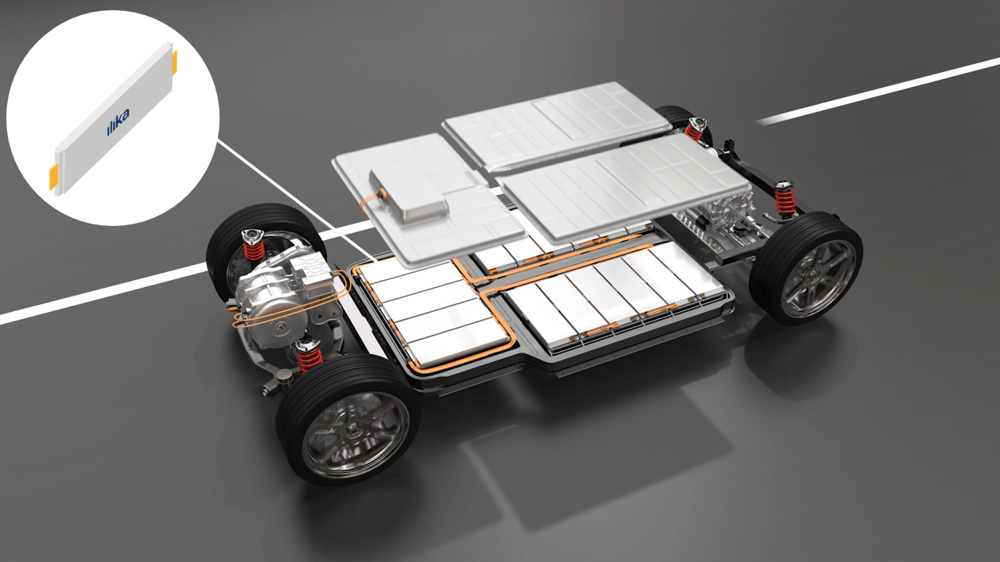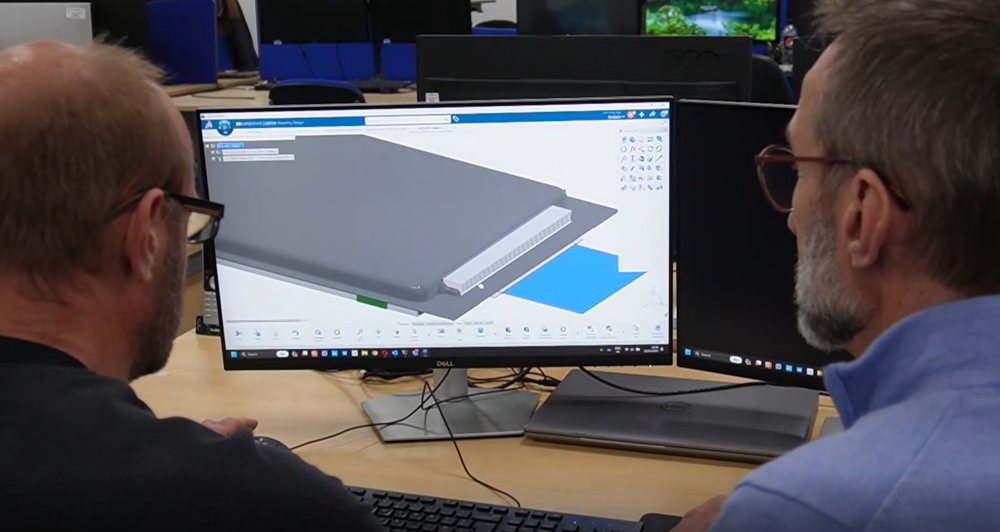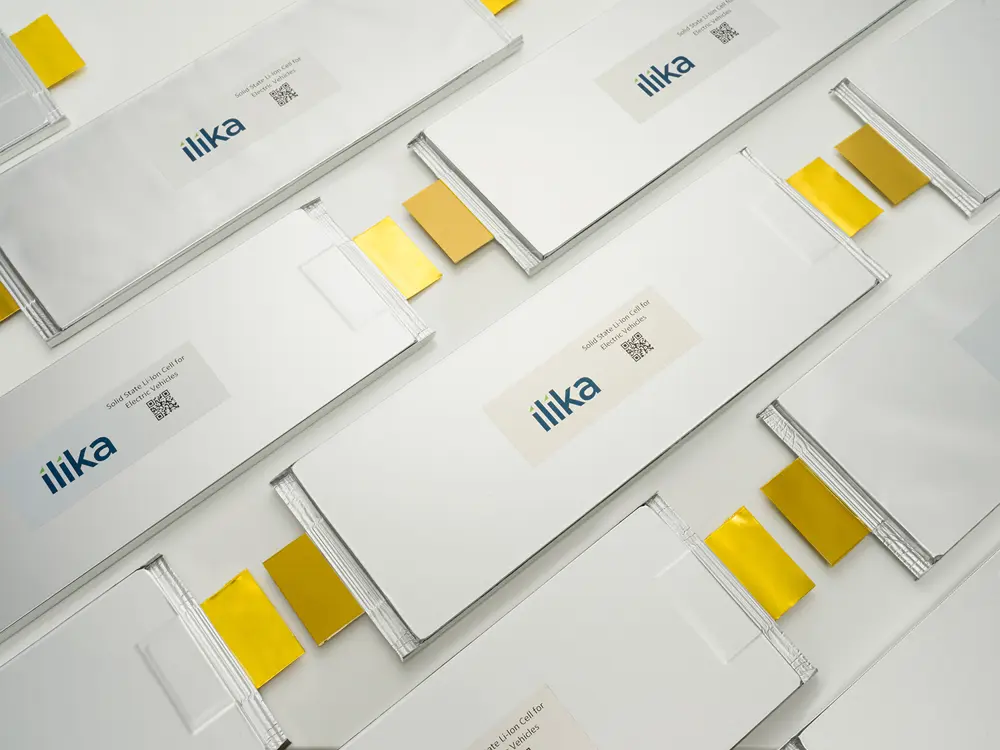
A solid future for electric vehicles
Did you know?
- Driving an electric car could save up to 80% of carbon emissions during a vehicle’s lifetime, compared with a petrol- or diesel-powered car
- Globally, more than 20% of new cars sold were electric in 2024, and sales topped 17 million
- Lithium-ion batteries used in electric vehicles do have some limitations such as their sustainability and slow charging times, which could be addressed by alternative battery technologies
The challenge of climate change and the need to reduce emissions of carbon dioxide and other greenhouse gases have prompted the rising popularity of electric vehicles (EV) as an alternative to burning petrol and diesel in internal combustion engines. The current generation of EVs rely on lithium-ion (Li-ion) battery packs to keep us mobile; yet the disadvantages of Li-ion batteries have hindered their mass adoption. Scientists and engineers in the UK are playing leading roles in the race to develop alternative technologies such as solid-state batteries.
Alternative battery technologies
Batteries can be made with a variety of materials and techniques. Different battery technologies could find applications in different sectors. For example, weight is not important in energy storage for power networks. Vanadium flow or sodium-ion batteries, for example, could work better as ground-mounted power sources for masts and antennae, where their relative lack of energy density is also less of a concern.
These batteries do have some advantages; sodium is abundant as an element, for instance. However, despite being a long-established alternative to Li-ion, the high cost of vanadium and issues around its lifecycle could render it unsuitable for vehicles. Similarly, sodium-ion costs more than lithium-ion, with a lower energy density, so it would increase a vehicle’s weight.
Lithium limitations
Firstly, the manufacture of Li-ion batteries requires scarce materials that can be environmentally damaging to extract, such as cobalt and graphite. Some of these materials can come from sensitive regions. For example, most of the world’s cobalt comes from the Democratic Republic of Congo, where an ongoing civil war, partly associated with mining operations, has triggered a humanitarian crisis. Most of the lithium used in Europe is imported from Chile, China and the US, increasing carbon emissions through its transportation. Furthermore, global demand for these raw materials is expected to exceed current production many times over.
Most of the lithium used in Europe is imported from Chile, China and the US, increasing carbon emissions through its transportation. Global demand for these raw materials is expected to exceed current production many times over.
Analysis carried out for the Royal Academy of Engineering’s critical materials report in 2024 found that the EVs projected to be sold in the UK from 2018 to 2040 would require 268,000 tonnes of lithium. A 30% reduction in vehicle battery sizes in the largest EVs sold in the UK by 2040 could save 46,000 tonnes of lithium.
The environmental issues of Li-ion batteries are compounded by the fact that recycling wasn’t a priority during their original development, making this a costly and complex process to retrospectively engineer. However, innovations in battery recycling are addressing this through processes such as solvent extraction, which aims to minimise how much battery material is eventually thrown away.
The second issue is that Li-ion batteries offer relatively limited range per charge, often necessitating more or larger batteries in each vehicle. This pushes up weight. Li-ion batteries also require sensors and control systems for fire and thermal management, further increasing weight and reducing range and performance.

A 3D rendering of a battery pack including Ilika solid-state cells © Ilika
Recharging an electric vehicle is slow compared to refuelling a conventional vehicle, which is also typically cheaper to buy. A patchy public charging network makes limited range and long charging times especially problematic for homes and businesses without secure off-street parking.
Various alternative battery designs could overcome some of the drawbacks of Li-ion batteries for vehicles. In The UK Battery Strategy, published in 2023, the Department for Business and Trade lists four technologies for ‘next-generation batteries’: sodium-ion, lithium-sulphur, metal-air, and solid-state.
Out of these, the UK is playing a leading role in the development of solid-state batteries. Solid-state is recognised as being able to address concerns about cost, range anxiety and charge speed, explains Graeme Purdy, the CEO of Ilika, a product development company working on solid-state batteries. “We found that more and more companies were interested in improved electrodes and improved electrolytes. Solid-state is seen as a way to better batteries and a better EV driving experience, which will add momentum to demand for EVs.”

Engineers designing a solid-state battery © Ilika
The hard cell
Purdy explains some of the advantages of solid-state cells over Li-ion cells: “In a normal lithium-ion cell, you’ve got a liquid electrolyte which is the medium through which the ions move.” “The electrolytes transfer lithium ions from the cathode to the anode when charging the battery, and then from the anode into the cathode as an electrical current is pulled through it.” In a Li-ion cell, a polymer separator divides the electrodes, whereas in a solid-state battery, Purdy adds, you typically replace the separator and the liquid electrolyte with a polymer or ceramic layer.
Solid-state batteries can use various alternative layers: a sulphide or oxide-based ceramic, or a polymer-based electrolyte. Ilika chose an oxide-based electrolyte. As Purdy explains: “The use of an oxide-based electrolyte ensures the layer is both ionically conductive to allow lithium ions to move back and forth, but also electrically insulating so the electrodes don’t short the battery.” The anode can be made out of silicon or pure lithium metal, giving it a smaller volume and greater energy density compared to the anodes required in Li-ion batteries, which are typically made of carbon or graphite. The battery can store more energy in the same volume, while charging time is cut by eliminating the charging bottlenecks experienced by traditional lithium-ion cells.
Safer by design
While Li-ion does have drawbacks, certain misconceptions have taken root among the public, such as the belief that these batteries are somehow unsafe. “The Swedish Fire and Rescue Department showed last year that EVs were 17 times safer than a normal internal combustion engine vehicle in terms of risk of fire to users of the vehicle,” says Purdy. However, that safety comes at an engineering cost: “You have to put in fire management, fire suppression systems, thermal management systems, and also mechanical protection to make sure the battery pack is safe for a vehicle.”
If a battery overcharges or flammable electrolytes leak out, the resulting fire temperature can trigger thermal runaway where successive cells ignite over a long period. Reducing the risk of this involves technologies such as fire suppression systems, which prevent and detect fires with early warning systems, spot cooling and extinguishing agents. Similarly, thermal management systems attempt to minimise component degradation and thermal runaway, using either passive or active cooling with air or liquids.
Purdy highlights the nail penetration test: “If you drive a nail through a battery, you get an explosive response with a traditional lithium-ion battery as an electrical short circuit occurs, whereas you get a much more muted response with solid-state batteries.” This is because the absence of flammable liquid electrolytes minimises the risk of fires or thermal runaway.
These and other safety gains enable vehicle manufacturers to strip out much of the cost and weight that has hindered Li-ion-powered vehicles.

Ilika's solid state battery is based on an oxide-based electrolyte © Ilika
“That means the vehicle is much more competitively priced, and it’s got a longer range,” says Purdy. If you can reduce the bill of materials by reducing the mechanical protection and battery pack safety engineering, that is reflected in the cost of the vehicle.
Another advantage of solid-state batteries is that you can charge them more rapidly, as the solid electrolyte allows the ions to move more quickly. Purdy cites a recent test where Balance Batteries, consultants in automotive powertrains, modelled an Ilika Goliath solid-state battery pack in a Hyundai Ioniq 5 EV. The model showed a reduction in the car’s weight by over 110 kilograms, a bill of materials slashed by £2,500 and charging time cut from 18 minutes to 12.
State of play
In another approach to solid-state batteries, Mauro Pasta, a Professor of Applied Electrochemistry at the University of Oxford, is the principal investigator of the Faraday Institution’s SOLBAT Next Generation Solid-State Batteries Project. The £25 million SOLBAT programme brings together seven UK-based companies and institutions to carry out fundamental research on anodes and cathodes as well as viable manufacturing processes for solid-state batteries.
Pasta agrees that cost is central to the long-term viability of solid-state batteries. “There are two ways of tackling the cost argument. You need to reduce the cost of the raw material – about 70% of the cost of a battery is raw materials – or you increase energy density. It’s a combination of the potential energy density advantages and cost that leads to solid-state. All the major automotive companies are working on this; everyone knows that if you want to have anything fully equivalent to the internal combustion engine, then solid-state will probably be the best way of achieving that.”
Pasta’s team is researching materials and battery design to get the performance needed. He also points out that battery recycling is also a focus. “We have a chance to design something that would be amenable to being recycled. You can envision designing a solid electrolyte that can selectively be dissolved to recoup the cathode material. It’s important to include a recycling design principle from the ground up – not doing what we did with lithium-ion, where it’s now difficult to come out with disposal approaches that are not dirty and expensive.”
The UK's battery research pedigree
The focus of the UK’s battery research is the Faraday Institution. Supported by UK Research and Innovation (UKRI), the Faraday Battery Challenge funds projects that, for example, cover degradation and how to extend battery life, safety and recycling.
The manifesto for UKRI support is the UK Battery Strategy. Published in 2023, on solid-state batteries, it says: “Experts highlighted solid-state, and cathode research as particular UK strengths, alongside a growing number of start-ups and a relatively strong position in equity investment, especially in next-generation anodes.”
In its most recent call for research proposals, UKRI reports that the UK has a healthy startup scene with more than 80 startups that have raised more than $2.4 billion in venture capital investment since 2018.
The UK’s battery programme includes the national battery development facility, the UK Battery Industrialisation Centre (UKBIC). Based in Coventry, the home of the UK’s automotive sector, this £200 million facility “bridges the gap between battery research and successful mass production”. The remit of UKBIC is to “provide battery manufacturing scale-up and skills for the battery sector, help companies develop battery manufacturing processes at the scale needed to move to industrial production.”
UKBIC’s activity also encompasses battery recycling, through its involvement on such activities as RECOVAS (Recycling of EV Cells from Obsolete Vehicles at Scale). With “over 164,000 pure electric vehicles on Britain’s roads”, RECOVAS, which ran from 2020 to May 2025, set out “to provide a standardised and reliable route for recycling and repurposing the lithium-ion batteries”.
Start small, think big
While vehicles are central to the adoption of solid-state batteries, the automotive market isn’t the only potential beneficiary of this emerging technology. “Historically, you don’t go straight to mass production,” explains Pasta. “People are looking for retail markets that will appreciate the advantages [of solid-state], and which will allow you to think about scale, generate some of the chemistry, and then move up. In the case of solid-state, it could be portable electronic devices, where manufacturers want energy density in a limited space.”
For example, Ilika came to EVs after working on other uses of solid-state batteries. “We’ve got two product lines,” says Purdy. “On the one hand, we’ve got miniature solid-state batteries that we call Stereax.” Ilika makes these batteries using a thin film deposition approach to create millimetre-scale batteries. These will be used in active implantable medical devices, such as blood pressure monitors, smart contact lenses, cardiac implants, and neurostimulators.
“About six years ago, we were increasingly being approached by automotive companies, who were saying ‘we’ve seen what you can do with solid-state batteries for medical devices, and we’re interested in improved products for automotive’. That’s when we started developing our Goliath product range for EVs.” These larger batteries use nickel–manganese–cobalt (NMC) in combination with a high-silicon electrode, which have a higher capacity that traditional graphite electrodes.
Charging towards a brighter future
Pasta is confident that solid-state batteries will happen. “In terms of solid-state battery packs that could be implemented in prototype models or high-performance cars, the leading battery manufacturers say that might be coming by 2029. I think we could have a sensible solid-state battery by then, but to then produce it at scale and really gain a substantial portion of the market might take longer.”
One complication is that Li-ion batteries are themselves being incrementally improved. “Lithium-ion is a moving target,” says Pasta. “More and more solutions are coming up that increase energy density by a few percent, storing more energy by optimising the pack. If something’s not superior to lithium-ion in most of the metrics, then the push toward replacing it is not going to be as strong, and it may take longer.
That’s going to be driven mostly by economics and less by the technical aspect, where you may have a solid-state battery that works, but it doesn’t work much better than lithium-ion.”
If solid-state cells can be mass-produced at an affordable rate, demand is likely to exceed supply for some time. So, Li-ion batteries are likely to remain in use for some time, with competing battery technologies operating alongside one another. UK scientists and engineers will be well placed to ensure the adoption of solid-state batteries in the transport industry and beyond.
Contributors
Professor Mauro Pasta is Professor of Applied Electrochemistry in the Department of Materials, University of Oxford. His research interests lie at the intersection between electrochemistry and materials chemistry to develop novel materials, devices and systems for energy conversion and storage. He has co-founded three battery startups: Natron Energy, Cuberg, and Project K.
Graeme Purdy is the Founding CEO of Ilika. He has led the company through two rounds of venture funding and floated it on AIM in 2010. Graeme is a Chartered Engineer, a Fellow of the Institution of Chemical Engineers and a Sainsbury Management Fellow.
Get a free monthly dose of engineering innovation in your inbox
SubscribeRelated content
Transport

The ‘flat-pack’ footbridge for train stations
If you thought flat-pack was just for furniture, think again! Find out how this new concept can make building a humble railway bridge take less time, money and carbon.

Electrifying trains and STEMAZING outreach
Alex Keeler, a railway overhead line design engineer at Amey, won this year’s Baroness Platt of Writtle Award for the most outstanding incorporated engineering application nationwide.

The entrepreneur solving engineering problems with data
Elspeth Finch MBE FREng started her first company in her 20s and is now heading up her second, which is using data to transform supply chain relationships.

How crashing cars can help us make them safer
When your day job sometimes involves totalling a £100k car in the name of keeping passengers safe.
Other content from Ingenia
Quick read

- Environment & sustainability
- Opinion
A young engineer’s perspective on the good, the bad and the ugly of COP27

- Environment & sustainability
- Issue 95
How do we pay for net zero technologies?
Quick read

- Transport
- Mechanical
- How I got here
Electrifying trains and STEMAZING outreach

- Civil & structural
- Environment & sustainability
- Issue 95